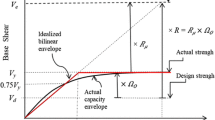Abstract
Analyses on RC frames designed as per the Indian standards (IS 1893:2002 and IS 13920:1993 (2008)) and draft proposal (IITK-GSDMA EQ 11 v 4.0, 2008) are done in this paper. Based on the results, certain provisions in the latest codes (IS 1893:2016 and IS 13920:2016) are reviewed. The study is focused on frames with vertical geometric irregularity. However, analyses of regular frames are also done to make certain comparisons. The necessity of strengthening/retrofitting for the buildings located in places whose seismic zones are revised as per IS 1893:2002 is also examined. Regular structures are found to sustain the earthquake events with sufficient safety. The design of regular frames can be made more economic by reducing their design base shear. The column/beam moment-capacity ratio (M.R.) in IS 13920:2016 is found uneconomical for regular frames. Improvements to the design of irregular frames can be made by reducing their response reduction (R) factors and following the M.R. value of 1.4 adopted in the recent code (13920:2016).




Similar content being viewed by others
References
Bureau of Indian Standards, New Delhi, IS 1893 Part 1, Indian Standard Criteria for Earthquake Resistant Design of Structures (2002)
Bureau of Indian Standards, New Delhi, IS 13920:1993, Ductile Detailing of Reinforced Concrete Structures Subjected to Seismic Forces—Code of Practice (Reaffirmed 2008)
N.R. Chandak, Response spectrum analysis of RC buildings. J. Inst. Eng. India Ser. A 93(2), 121–128 (2012). https://doi.org/10.1007/s40030-012-0012-9
Y. Singh, V.N. Khose, D.H. Lang, A comparative study of code provisions for ductile RC frame buildings, in Proceedings of the 15 WCEE, LISBOA (2012)
V. Prakash, Whither performance-based engineering in India? ISET J. Earthq. Technol. 41(1), 201–222 (2004)
MdS Bari, T. Das, A comparative study of seismic analysis of Bangladesh National Building code (BNBC) with other Building codes. J. Inst. Eng. India Ser. A 94(3), 131–137 (2013). https://doi.org/10.1007/s40030-014-0053-3
S.K. Jain, Review of Indian Seismic Code IS1893 (Part 1): 2002, Indian Concr. J. 77, 1414–1422 (2003)
P. Haldar, Y. Singh, Seismic performance and vulnerability of Indian code designed RC frame buildings. ISET J. Earthq. Technol. 46(1), 29–45 (2009)
S.M. Rizwan, Y. Singh, Effect of strength eccentricity on torsional behaviour of RC frame building. J. Inst. Eng. India Ser. A 93(1), 15–26 (2012). https://doi.org/10.1007/s40030-012-0004-9
S.V. Itti, A. Pathade, R.B. Karadi, A Comparative Study on Seismic Provisions Made in Indian and International Building Codes for RC buildings, www.sefiindia.org. Accessed on 25 April 2014
Bureau of Indian Standards, New Delhi, IS 13920:2016, Ductile Design and Detailing of Reinforced Concrete Structures Subjected to Seismic Forces (2016)
Bureau of Indian Standards, New Delhi, IS 1893 Part 1, Indian Standard Criteria for Earthquake Resistant Design of Structures (2016)
Bureau of Indian Standards, New Delhi, IS 456:2000, Indian Standard, Plain and Reinforced Concrete (2000)
S.K. Jain, C.V.R Murthy, Proposed draft provisions and commentary on ductile detailing of RC structures subjected to seismic forces, in IITK GSDMA EQ 11 v 4.0, Final Report A—Earthquake Codes, IITK GSDMA Project on Building Codes (2008)
SAP 2000 NL, V 14.0 (Computers and Structures, Inc., Berkeley, 2008)
STAAD Pro—Bentley Systems (2006)
H.J. Shah, S.K. Jain, Design Example of a Six-Storey Building, Document No. IITK-GSDMA-EQ 26-V3.0 (2008)
T.L. Karavasilis, N. Bazeos, D.E. Beskos, Seismic response of plane steel MRF with setbacks: estimation of inelastic deformation demands. J. Constr. Steel Res. 64, 644–654 (2008)
P. Sarkar, A.M. Prasad, D. Menon, Vertical geometric irregularity in stepped building frames. Eng. Struct. 32, 2175–2182 (2010)
G. MacRae, B. Deam, Building Regularity for Simplified Modelling, EQC Project No. 06/514, University of Canterbury, New Zealand (2009)
G.H. Powell, Performance Based Design using Nonlinear Analysis. Seminar Notes (Computers and Structures, Inc., Berkeley, 2006)
M. Inel, H.B. Ozmen, Effects of plastic hinge properties in nonlinear analysis of reinforced concrete buildings. Eng. Struct. 28, 1494–1502 (2006)
FEMA 356, Prestandard and Commentary for the Seismic Rehabilitation of Buildings (American Society of Civil Engineers, Reston, 2000)
A. Formisano, G. De Matteis, F.M. Mazzolani, Numerical and experimental behaviour of a full-scale RC structure upgraded with steel and aluminium shear panels. Comput. Struct. 88, 1348–1360 (2010)
ASCE Standard, ASCE/SEI 7-05, Minimum Design Loads for Buildings and other Structures (2005)
http://www.peer.berkeley.edu/. Accessed on 10 Aug 2014
European Committee for Standardization (CEN), Brussels, BS EN 1998-1, Eurocode 8 Part-1: General Rules, Seismic Actions and Rules for Buildings, Design of Structures for Earthquake Resistance (2004)
C.V.R. Murthy, Earthquake Tip-4, Learning Earthquake Design and Construction (IIT Kanpur, BMTPC, New Delhi, 2002)
G. De Matteis, A. Formisano, F.M. Mazzolani, An innovative methodology for seismic retrofitting of existing RC buildings by metal shear panels. Earthq. Eng. Struct. Dyn. 38, 61–78 (2009)
New Zealand Standard-Concrete Structures Standard, Part 1 The Design of Concrete Structures, Incorporating amendments 1 and 2, NZS 3101-Part 1: 2006 (2008)
ACI Committee 352, 352R-02: Recommendation for Design of Beam-Column Joints in Monolithic Reinforced Concrete Structures (American Concrete Institute, Farmington Hills, MI, 2002)
E.D. Booth, D. Key, Earthquake Design Practice for Buildings, 2nd edn. (Thomas Telford, London, 2006)
Funding
The authors are thankful to Ministry of Human Resources Development, Govt. of India for Funding this project.
Author information
Authors and Affiliations
Corresponding author
Rights and permissions
About this article
Cite this article
Manjula, N.K., Nagarajan, P. & Madhavan Pillai, T.M. Performance Evaluation of RC Buildings Designed as per Indian Seismic Codes: A Study on Frames with Vertical Geometric Irregularity. J. Inst. Eng. India Ser. A 99, 677–687 (2018). https://doi.org/10.1007/s40030-018-0324-5
Received:
Accepted:
Published:
Issue Date:
DOI: https://doi.org/10.1007/s40030-018-0324-5




